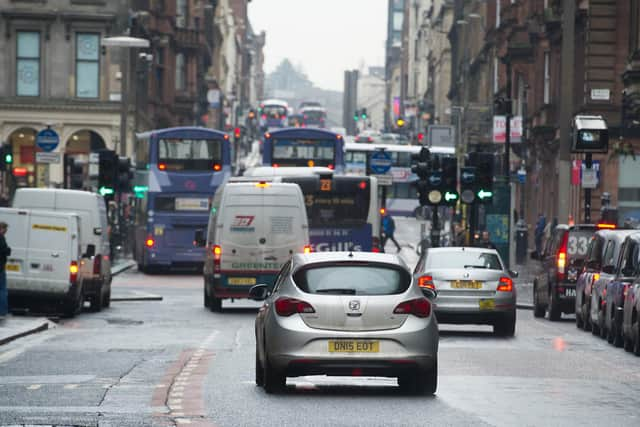Scotland meets 2022 air pollution limits thanks to clean air zones
New information has been released showing Scotland did not breach legal air pollution limits in 2022 for the first time, excluding the impact of Covid lockdowns in 2020.
Legal air quality standards came into force in 2010, but have been broken every single year with the exception of 2020 when the lockdowns resulted in a big drop in car journeys.
Advertisement
Hide AdAdvertisement
Hide AdEnvironmental campaigners say the improvement in air quality in Scotland's cities shows the early benefits of Low Emission Zones (LEZ). The biggest improvements were seen in Glasgow, where the LEZ is already up and running.


Friends of the Earth Scotland analysed official air pollution data for 2022, looking at two toxic pollutants that are produced by transport. The provisional data suggests that air quality across Scotland was within legal limits in 2022.
The European Ambient Air Quality Directive set a limit for Nitrogen Dioxide (NO2) of 40 micrograms per cubic metre.
The results are shown below:
The Scottish annual statutory standard for particulate matter (PM10) is 18 micrograms per cubic metre and several areas in Scotland are below this.
Renfrewshire Johnston High Street had the lowest rate at 12.88, while Perth Atholl Street had the highest at 15.89.
In 2021, Glasgow's Hope Street broke the legal limit for diesel pollution, and has seen one of the biggest improvements this past year.
Glasgow's Low Emission Zone began in 2019, restricting polluting buses. Now every bus going through the city centre has to meet the minimum emission standard, with private cars to follow in June this year.
The Scottish Government has provided grants for buying new buses or retrofitting older buses to met the criteria.
Advertisement
Hide AdAdvertisement
Hide AdGavin Thomson, transport campaigner at Friends of the Earth Scotland, said: "It's great that progress is being made to improve some of our most polluted streets.
"People in Glasgow can breathe a little easier as a result of the Low Emission Zone and fewer polluting vehicles in the city centre. The buses along Hope Street these days are often electric, which are better for the climate and for our lungs.
"The Low Emission Zones coming to Aberdeen, Edinburgh and Dundee will bring similar improvements and protections for public health - but for Scotland's other cities such as Inverness and Perth, toxic air pollution persists with no clear plan for addressing it.
"When it comes to air pollution, we know what works. Councils need to invest in walking, wheeling and cycling, and take control of public transport. Every city with a pollution problem should be looking at Low Emission Zones."
Air pollutions puts the population at risk of serious health issues such as asthma, strokes and heart attacks.
It can be especially harmful to children, the elderly, and people living in poverty or made vulnerable from other health conditions.
Joseph Carter, head of Asthma and Lung UK Scotland, said: "It is good news this year that air pollution on our streets has been kept within its legal limits, yet there is obviously more that can be done. We need the Scottish Government to make tackling air pollution a national priority.
"Air pollution is the biggest environmental threat to public health. At a cost of £1.1 billion per year to the NHS, it is draining our resources, straining our health system and cutting short over 2,500 lives a year in Scotland."